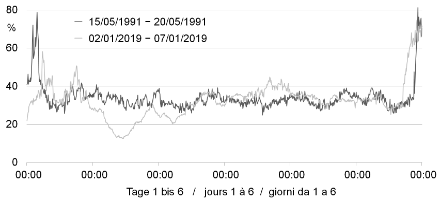Service Navigation
Search
Apart from a few extremely long foehn periods, the longest foehn periods recorded in the foehn index are roughly the same on both sides of the Alps. In Altdorf and Poschiavo, the periods are usually shorter than 80 hours. In Chur, the longest periods usually remain below 70 hours, in Vaduz below 60 hours and in Lugano below 50 hours. At the Visp weather station in the Valais, the foehn periods rarely last for longer than 40 hours.
The longest measured foehn period
The longest ever foehn period to be measured in Switzerland on the basis of the foehn index was recorded at the Poschiavo weather station on the southern side of the Alps. In January 2019, the foehn blew here for almost 131 hours, or around 5.5 days, without interruption.
Unfortunately, the foehn index at the Poschiavo weather station only dates back to 2008. In the period with automatic measurements from 1981 onwards, the Poschiavo measurement series contains at least one other similarly long foehn period: In mid-May 1991, Poschiavo recorded an uninterrupted foehn period of just over 137 hours, or 5.7 days. The data indicate that Poschiavo, which is close to the Alps, tends to have the occasional very long foehn period.
The extremely long foehn period of May 1991 can be easily recognised from the ten-minute humidity values (40% or lower) and the flow position (northern position over Switzerland, according to the annals of the Swiss Meteorological Institute). The event started shortly after midnight on the first day and ended shortly before midnight on the sixth day (dark grey curve in the line diagram). According to the foehn index, the similarly long foehn period in January 2019 began on the first day between 6:10 and 6:20 hours and ended on the evening of the sixth day (light grey curve in the line graph).

The unusual foehn record of 2016
The foehn on the northern side of the Alps in 2016 turned out to have an extremely long duration. From 2nd to 5th April, it blew for 65 hours, or almost three days, without interruption at the Altdorf weather station.
In May, the foehn significantly increased its staying power again. From 5th to 7th May, it was present for 42 hours, followed by a short interruption of 2 hours and 20 minutes. This was followed by a 93-hour period (just under four days) without interruption until 11 May. Both periods together result in a foehn duration of 136 hours, i.e. around 5.5 days.
In November 2016, Altdorf experienced its third long foehn period within a year. From 20th to 24th November, the foehn swept over the weather station for 109 hours, or 4.5 days, without interruption. In the almost 40-year automatic measurement period at the traditional foehn location of Altdorf, there has not been a year with more than two foehn periods of over 60 hours.